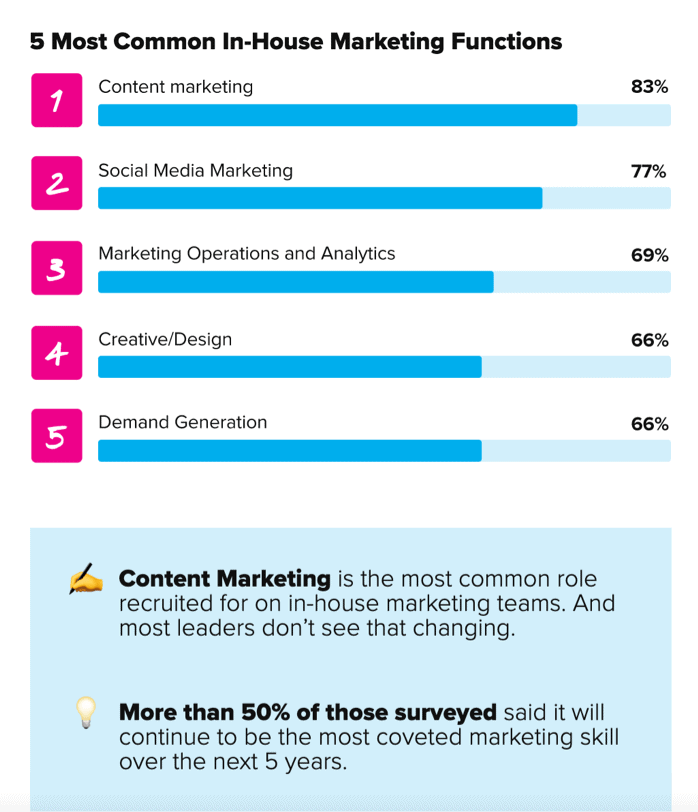
Before we start, you should know – a content marketer wrote that title ?♀️
Hear me out though, because the data is on my side.
Earlier this year, we conducted a study of 130+ marketing leaders to understand the technology, trends, and talent defining marketing today.
As part of that survey, we asked which marketing functions leaders had in-house (and which functions they thought would be most valuable in the future).
In both cases, content marketing came out on top ?
But why are so many leaders betting on content marketing?
The reason is pretty simple: Content is the backbone of any integrated marketing campaign – from the emails you send to the eBooks you publish to the copy on your landing pages ?
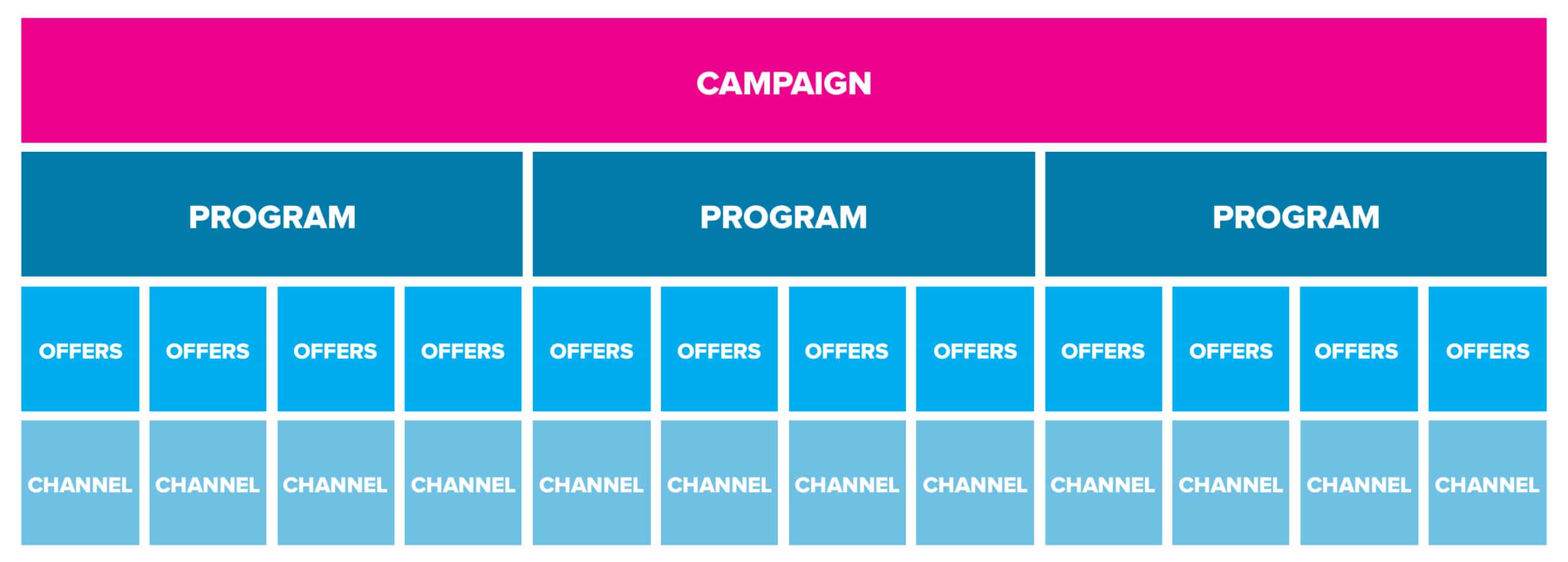
Content marketing is also the personality people associate with your brand (i.e., your brand voice). A well-established brand voice gives you more authority and trust with your audience.
…But not all content is created equal.
Great, stand-out content drives results, persuades, generates demand, and grows your audience. Creating content that delivers on all of these objectives can be daunting. And if that weren’t enough, “good” writing is also somewhat subjective.
So, I decided to reach out to other marketers on LinkedIn to get their two cents on what “great” content marketing looks like (and to see what they were working on) ?
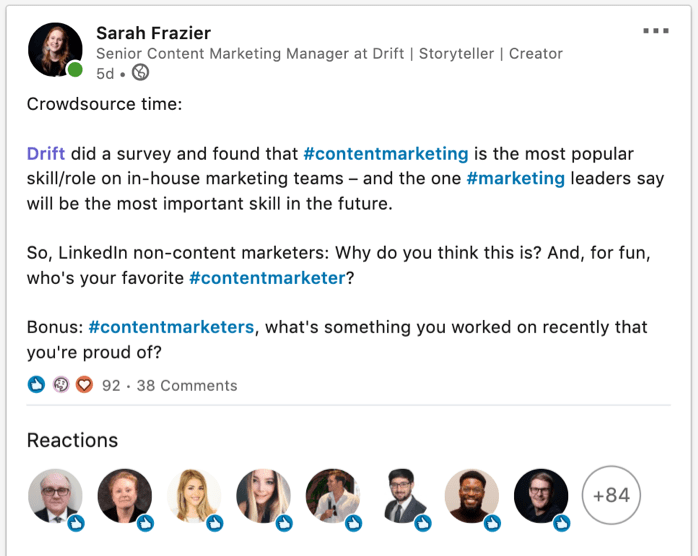
Looking at their responses, here are the five ingredients that seem to be fundamental…
1. Great Content Marketing is Relevant
Relevancy matters. As Erin points out here, that might mean pivoting your best-laid plans and focusing on what matters now to your key audience ?
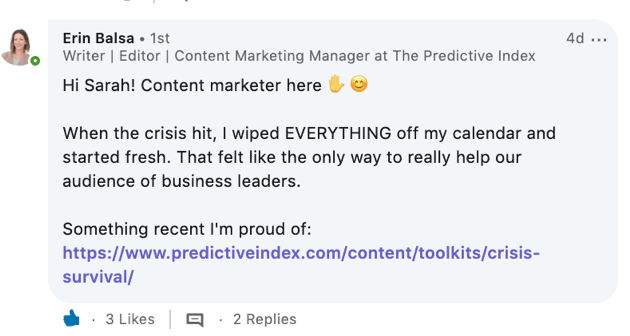
While the pandemic gave marketers plenty to write about, they aren’t just doing it to be topical. The pandemic introduced new challenges for everyone. Meaning what your buyers and customers cared about six months ago probably looks different today.
Even outside our current climate, relevancy was always a staple of good content marketing. Here are a few ways to keep tabs on what your buyers care about now:
- Talk to your customers or sit in on calls.
- Dig into some persona research. Develop topics from those pain points.
- Read, listen, watch, and consume the same content as your target audience.
- Keep on top of current events that impact your industry. Do this by subscribing to newsletters, setting up Google Alerts, and joining online communities and forums.
2. Great Content Marketing is Conversational
A conversational approach to content marketing impacts what you write and how you write. Here’s what that means in a nutshell:
Content marketing shouldn’t be an echo chamber
It would’ve been easy for me to tell you what I think makes content compelling. But – I like data. I like research. And I’m the first to admit that I don’t know it all. That’s the reason I chose to reach out to other content marketers on LinkedIn.
I don’t want my writing to live in an echo chamber.
A conversational approach to content marketing means pulling in other experts vs. simply writing in isolation. This gives your content more authority and your readers more value.
If you’d prefer using your own data, but aren’t equipped to run a massive study, start small:
- Anonymize the product and customer data you already have.
- Use free versions of survey tools like Typeform and SurveyMonkey to start conducting small surveys. (LinkedIn also released a new polls feature that is a big win for content marketers.)
- Partner with brands that can do the surveying for you.
Talk like a person, not like a corporate robot
People don’t buy from companies, people buy from people. That’s why we write like we talk at Drift.
We use short, snappy sentences. We use punctuation to break up longer thoughts and add clarity.
But we’re not alone in this approach. For example, copywriter extraordinaire Eddie Shleyner’s writing style is built around dialogue. He literally writes copy like a two-way conversation ?
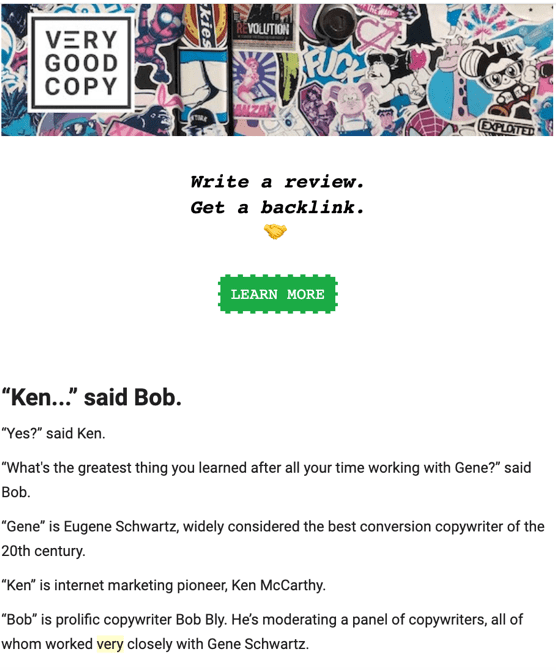
It’s compelling. It makes me want to read more. I feel like I’m there with him. And it provides a lot of value. (Subscribe to VeryGoodCopy – spoiler, it’s very good.)
3. Great Content Marketing is Consistent
Writing is like a muscle. It gets stronger the more you use it.
Allison here mentioned that – despite looking for a new job – she felt it was important to consistently write and publish. Not only does this help her improve her writing over time, but it gives her personal brand more visibility.
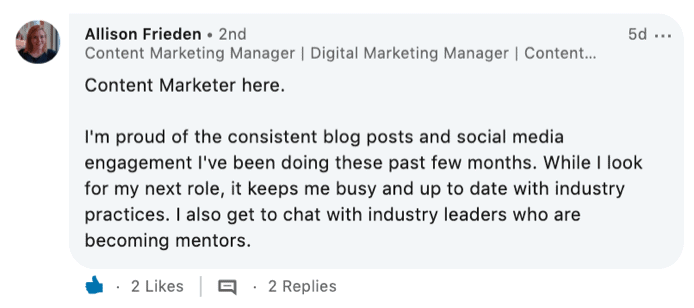
The same is true for any brand.
Shipping daily and having a bias for action is a leadership principle at Drift. This drives more results for us in the long run.
Sometimes marketers get so caught up in being “extraordinary” that they hold back and wait for that perfect idea. I’m here to tell you – there’s no such thing as perfect.
If you want to build an audience, generate demand, and get people to care about your product/services/company, then you need to get your message out there.
To be more consistent in your publishing, add a “publishing” metric to your performance tracking. Do this in something as simple as a spreadsheet.
Then, start looking at the performance of those posts overtime on Google Analytics. What’s working? What’s not working? How have unique visits been impacted? What benefits are you seeing on the demand side?
Aim to publish at least three times a week and then move up to five. Because with content, sometimes more really is more.
4. Great Content Marketing is Actionable
For your content marketing to be valuable it needs to be actionable.
To do that, you need to understand its purpose. For content marketers, our purpose is all about persuading people to care about XYZ and proving value.
John is a revenue operations consultant ?There’s still a lot about revenue operations people aren’t familiar with. So, he’s creating resources to teach his audience more about it, and how it functions alongside marketing, sales, and customer success. The purpose of John’s series is to get more companies to embrace revops.
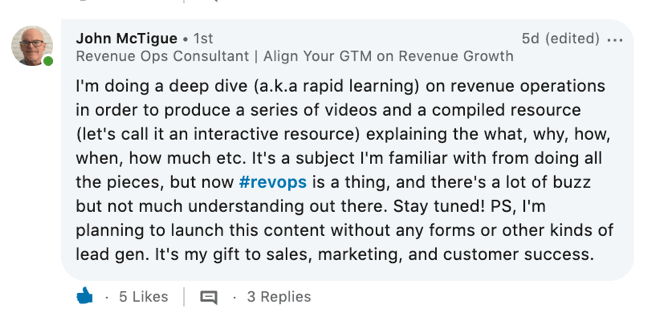
Persuasive writing should always give people tools they can use now. Whether that’s expertise, step-by-step instructions, toolkits, etc. In other words, let people put your theory to the test.
5. Great Content Marketing is Media-Agnostic
Your content marketing isn’t limited to the written word.
If you can provide value in a quick, 2-minute video better than you can in a 15-page report – do that. If your audience is more likely to read a blog than listen to a podcast – do that.
As a marketer, you should be open to creating content in whatever format is most valuable to your audience.
I love this quote from Gong during Drift’s New Funnel for a New Decade virtual summit. It’s a great reminder that valuable content comes in many forms:
“You want to create content that’s easily digestible, where buyers or customers can learn something new and put that information to use today. How do you do that? You do that with a two-minute video, 600-word article, or 20-minute podcast. You do it with something that’s easily digestible, that your buyers and customers can learn something practical from now.”
I saw this same media-agnosticism hyped in my LinkedIn thread as well:
Shannon and the team at Quick Base are telling personal stories in their “New Normal” YouTube series. They’re also writing blogs that provide guidance and tactical solutions for WFH ?
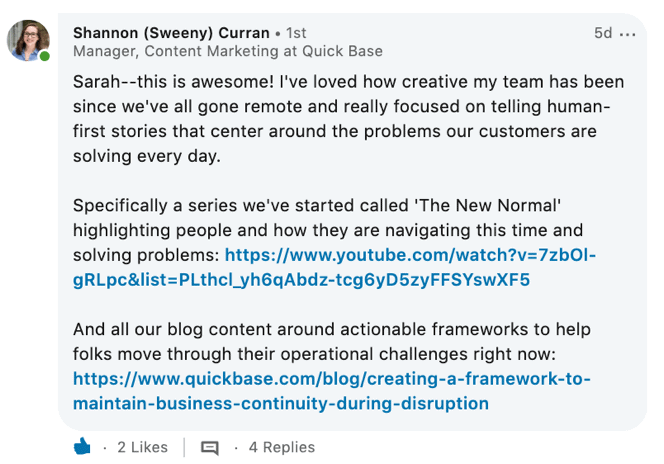
Experimenting with different content formats might mean getting out of your comfort zone.
To get your feet wet, pick some of your best content that’s already proven successful. Come up with 2-3 new formats for that content to be reused: webinars, one-off videos, podcasts, blogs, etc. Pick a month, and publish those formats once a week. Make sure to give them an equal amount of promotion. See what format performs the best with your audience.
You don’t need to make that format the be-all-end-all. But it will help to inform the rest of your content strategy.
Wrapping Up
I’m sure there are countless lists out there with “15+ content marketing tips and tricks to crush your goals.”
But the principles here are broad for a reason.
They can be applied no matter the scope and size of your team. And they focus on getting the fundamentals right.
Thank you to everyone who replied to my original LinkedIn post! If you have any other “content writing best practices” you’d like to share – the original LinkedIn thread is still very much open, so give me a holler.




